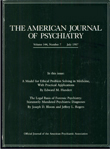Relative efficacy of haloperidol and pimozide in children and adolescents with Tourette's disorder
Abstract
OBJECTIVE: The authors evaluated the relative efficacy and safety of pimozide and haloperidol in the treatment of Gilles de la Tourette's syndrome in children and adolescents. METHOD: A double-blind, 24-week, placebo-controlled double crossover study of equivalent dose formulations of haloperidol and pimozide was conducted with 22 subjects, aged 7-16 years, with Tourette's disorder who were randomly assigned to first one active drug treatment and then the other. Biweekly assessment and flexible dose titration mimicked clinical practice. The primary outcome variable was total score on the Tourette Syndrome Global Scale. Final outcome was determined after 6 weeks of each treatment (placebo, pimozide, haloperidol), with a 2-week placebo baseline period and intervening 2-week placebo washout periods between treatments. RESULTS: Pimozide proved significantly different from placebo in affecting the primary outcome variable, whereas haloperidol failed to have a significant effect. Haloperidol exhibited a threefold higher frequency of serious side effects and significantly greater extrapyramidal symptoms relative to pimozide. Haloperidol-associated treatment-limiting adverse events were experienced by 41% of the patients. The therapeutic doses of pimozide and haloperidol were equivalent (mean = 3.4 mg/day, SD = 1.6, and mean = 3.5 mg/day, SD = 2.2, respectively). CONCLUSIONS: At equivalent doses, pimozide is superior to haloperidol for controlling symptoms of Tourette's disorder in children and adolescents.



